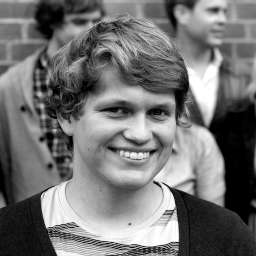German director Christof Loy’s second production for the Royal Swedish opera was of Wagner’s Parsifal. The cast is rather on the luxurious side as well, sporting three of the greatest Wagner singers working today – two of them Swedish, no less!
Loy’s Parsifal is a distinctly human drama. It is still the story of the “pure fool” Parsifal conquering the evil Klingsor to regain the lost holy spear, and the grail is still a grail. But Loy sees the characters of Parsifal primarily as humans, not as mythical figures. This is perhaps most apparent in the beginning, as the apprentices make their way into Gurnemanz’s cottage, some yawning, some even falling asleep during their prayer and then some kneeling and praying even more fervently than Gurnemanz himself. Kundry is shown in the first act as a normal woman, not the manic madwoman that is all too common. The only unsettling moment is when she tells Parsifal of his mother’s death, a jarring moment that doesn’t resolve itself until her confession in Act II.
Klingsor’s palace in Act II is for the first half a commentary on how art has become a commodity, pure entertainment. Klingsor enters, dressed in tails with a cane and top hat, a parody of a kind of early 20th-century bourgeoisie, and starts tormenting the six flower maidens he has kept in his room. The flower maidens are all dressed as ballerinas, and one even spins around en pointe to satisfy her master. The flower maiden scene happens in a garden, although this garden is made entirely out of painted flats. It’s mere theatre, an illusion. As Parsifal catches the spear thrown at him by Klingsor, the whole set collapses, and thus the illusion, Klingsor’s power, is broken.
The perhaps most radical element of Loy’s production is that Amfortas is not given absolution in the final act. As the Grail Ceremony proceeds, the grail is never uncovered. Instead, the back wall opens to a modern library. Is knowledge the new religion? Throughout, a large book, seemingly a sort of annals or chronicle kept by Gurnemanz has been written in. Kundry reads of Parsifal’s parents in it. The preservation of knowledge has been a recurring theme. The centrepiece of the library is a painting of Titurel, Gurnemanz’ father receiving the grail, recreating a tableau shown in the first act. The ending is very much downplayed; as the characters leave, the only one remaining is Amfortas, staring into the audience and the people in the library. Is this the direction the order will take under the leadership of Parsifal?
The cast was uniformly excellent. It was a pleasant surprise that nearly all of the characters, with the exception of Christof Fischesser’s Gurnemanz, were sung by Swedish singers. The title role was sung by Michael Weinius and his bright voice gave his Parsifal a welcome edge of youth and naïveté, but there was still plenty of power for the more dramatic moments. He also moved well on stage, although his acting was perhaps not the most gripping. Katarina Dalayman’s Kundry was a complete triumph. She is more than up to the task of Kundry, with both the manic, choppy lines of Act I and the soaring lyricism of Act II. Her range is also equally impressive, with a radiant top and powerful low notes. She is also a wonderful actress and brought out the tragedy of Kundry most effectively. Martin Winkler’s Klingsor was something of a caricature, behaving rather like a comic-book villain than anything else. Still, he did show vulnerability during his scene with Kundry. His singing was good, with an appropriately acidic edge to his tone.
One of the biggest highlights of the evening was Christof Fischesser’s touchingly human Gurnemanz, showing an almost endless display of vocal colours and shadings during his Act I monologues, making them almost the most exciting part of the whole show. He managed well the balancing act between compassion and authority so crucial to this role, often leaning more towards the compassionate and understanding side. Ola Eliasson’s Amfortas started out as perhaps the biggest disappointment, sounding unsteady vocally and also having audibility issues in the first act. He sounded a lot better when he returned for Act III, and in any case he gave a very compelling performance as an unusually conflicted ruler.
Conductor Patrik Ringborg gave a rather brisk reading of Parsifal further accentuating the human aspects of the drama. Instead of the sometimes leaden nobility that has been so common for especially this of all Wagner’s operas, Ringborg’s Parsifal was quintessentially human. That is not to say that the nobility wasn’t there, but it never overshadowed the humanity, and it made no attempts to portray itself as sacred or holy in any way. The orchestra sounded full and rather dense, although the occasional transparency was achieved. There were also some very good playing from the oboes and the brass section.
The Swedish Royal Opera’s new production of Parsifal is very much a success. Christof Loy’s attractive and thought-provoking production, world-class singing from a mostly Swedish cast, and superb playing from the orchestra all come together to provide a truly memorable experience and a Parsifal that would be hard to better.


